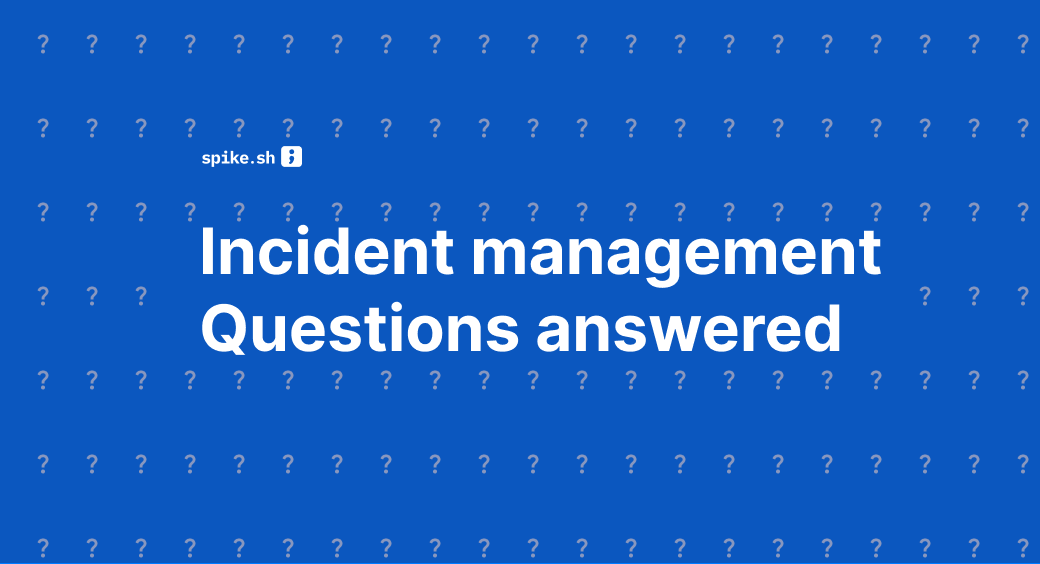Incidents are like unexpected storms—they might catch you off guard, but they're a part of the journey.
The silver lining? How you steer through these storms can make all the difference for your business.
Think of this post as your trusty compass, guiding you through the most common questions and curiosities about incident management.
Ready for the voyage? Let’s set sail!
1. What Is the Goal of Incident Management?
What’s the endgame of incident management? Simple: Get things back to normal as soon as possible while minimizing the adverse impact on business operations. This ensures the highest possible levels of service quality and availability are maintained.
2. What Is Triage in Incident Management?
Imagine you’re in a medical drama, and doctors are prioritizing patients based on their conditions. That’s triage! In the software world, it’s pretty similar. It involves determining the severity, impact, and urgency of each incident to decide on the order of response and allocation of resources.
3. What Is a Critical Incident?
A critical incident? It’s one that significantly disrupts normal operations or poses a serious risk to the organization’s stability and security. They are usually high severity (and/or high priority) and often require immediate attention and swift action to prevent extensive damage or loss.
4. What Are Response Time and Resolution Time?
Response time is the duration between the reporting of an incident and the moment the team begins working on it. Resolution time is the total time taken to fully resolve the incident.
5. What Integrations Do You Need to Create?
A general rule of thumb we recommend—ask yourself (or your team) on every module they created, what could go wrong. Set up monitoring and alerts for these modules. This helps you pick the integrations suitable for your business.
Spike offers 80+ integrations with leading monitoring tools, cloud platforms, and more. Plus, we provide Webhook integration which is incredibly flexible and fits in anywhere from Terraform to unlisted integrations.
6. What Are MTTI, MTTA, and MTTR?
Mean Time to Identify (MTTI) refers to the average time taken to identify an incident.
Mean Time to Acknowledge (MTTA) is the average time taken to acknowledge an incident.
Mean Time to Resolve (MTTR) is the average time taken to resolve an incident once it has been acknowledged.
7. When Should You Implement an Incident Management System?
We recommend implementing an incident management system if you're navigating a complex software ecosystem, frequently rolling out new updates, striving to keep your services up and running 24/7, scaling up your operations, adhering to tight regulatory standards, or simply aiming to stay ahead of the curve with a forward-thinking approach.
It's all about being efficient, responsive, and proactive in tackling issues before they snowball, ensuring a seamless experience for your users and a smoother ride for your team.
8. How Do You Integrate Incident Management with Continuous Deployment?
To integrate incident management with continuous deployment, you should establish a system where automated monitoring tools continuously scan for anomalies, triggering alerts that feed into an incident management platform. This ensures that any issues detected during deployment are immediately logged as incidents, assigned to the appropriate team members, and addressed swiftly.
Also, the process should be supported by real-time communication tools for team collaboration, post-deployment testing for assurance, and a feedback loop to continuously improve deployment strategies based on incident learnings.
9. How Are On-Call Schedules Typically Organized?
Ever wonder who’s holding down the fort after hours? That’s where on-call schedules come in. On-call schedules are typically organized in shifts to ensure that there is always a designated responder available outside of normal working hours. These shifts often rotate among team members to balance the workload.
10. How Do You Handle Multiple Incidents Occurring Simultaneously?
Got a bunch of incidents on your plate? First up, check if they're linked. Often, there's a common culprit behind them. Nailing that can solve the whole bunch in one go. Next, prioritize! Which ones hit hardest? Deal with those first. Plus, allocate resources efficiently and call in for additional support if necessary.
To make your life easier, Spike automatically suppresses repeat incidents once they’re acknowledged. This way, you're not swamped with noise and can focus on what really matters. And to keep everyone on the same page, you can set up “war rooms” on Spike. So, no more messy back-and-forths, just straight-up solving!
11. What Is the Difference Between Priority and Severity?
Priority refers to the order in which an incident needs to be addressed, considering its impact on business operations.
Severity is a measure of the extent of the incident and the level of damage or disruption it causes.
Wrapping Up
That’s the end of the voyage! We've navigated the choppy waters of incident management together. From the nuances of triage to the intricacies of on-call schedules, we've covered a lot of ground.
Remember, the key to smooth sailing is staying prepared, communicating clearly, and always striving for improvement.
Here's to sailing through incidents with newfound knowledge and confidence! 🥂

